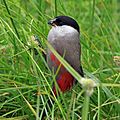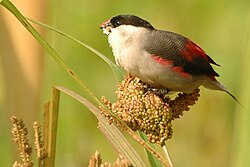| Image | Scientific name | Common name | Distribution |
|---|
 | Black-crowned waxbill | Estrilda nonnula | Nigeria and Cameroon to southeast Sudan, west Kenya and northwest Tanzania |
 | Black-headed waxbill | Estrilda atricapilla | Angola, Burundi, Cameroon, the Republic of Congo, the Democratic Republic of the Congo, Equatorial Guinea, Gabon, Kenya, Rwanda and Uganda |
 | Kandt's waxbill | Estrilda kandti | central Africa |
 | Orange-cheeked waxbill | Estrilda melpoda | Angola, Benin, Bermuda, Burkina Faso, Burundi, Cameroon, Central African Republic, Chad, the Republic of Congo, Côte d'Ivoire, the Democratic Republic of the Congo, Equatorial Guinea, Gabon, Gambia, Ghana, Guinea, Guinea-Bissau, Liberia, Mali, Mauritania, Niger, Nigeria, Puerto Rico, Rwanda, Senegal, Sierra Leone, Togo, and Zambia |
| Anambra waxbill | Estrilda poliopareia | southern Nigeria |
 | Fawn-breasted waxbill | Estrilda paludicola | Angola, Burundi, Central African Republic, the Republic of Congo, the Democratic Republic of the Congo, Ethiopia, Gabon, Kenya, Rwanda, South Sudan, Tanzania, Uganda and Zambia |
 | Common waxbill | Estrilda astrild | Sierra Leone, Liberia, Ivory Coast, Gabon, Nigeria, Namibia, Angola, South Africa, Botswana, Ethiopia, Tanzania, Malawi, Kenya, Uganda, Rwanda, Burundi, Mozambique, Cameroon |
| Black-lored waxbill | Estrilda nigriloris | Democratic Republic of the Congo |
 | Black-rumped waxbill | Estrilda troglodytes | Benin, Burkina Faso, Cameroon, Central African Republic, Chad, The Democratic Republic of the Congo, Côte d'Ivoire, Eritrea, Ethiopia, France (introduced by Guadeloupe), Gambia, Ghana, Guadeloupe, Guinea, Kenya, Liberia, Mali, Mauritania, Niger, Nigeria, Portugal (introduced), Puerto Rico, Senegal, Sudan, Togo, Uganda |
 | Crimson-rumped waxbill | Estrilda rhodopyga | Burundi, The Democratic Republic of the Congo, Djibouti, Egypt, Eritrea, South Africa, Ethiopia, Kenya, Malawi, Rwanda, Somalia, Sudan, Tanzania and Uganda |
| Arabian waxbill | Estrilda rufibarba | Yemen and southwestern Saudi Arabia |
|








